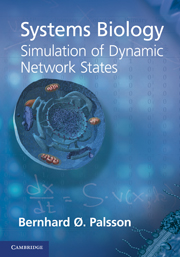Book contents
10 - Glycolysis
from PART III - METABOLISM
Published online by Cambridge University Press: 05 August 2012
Summary
Glycolysis is a central metabolic pathway. In this chapter, we formulate a MASS model of the glycolytic pathway. In doing so, we detail the process that goes into formulating, characterizing, and validating a simulation model of a single pathway. First, we define the pathway, or, more accurately stated, the system that is to be studied and characterized through dynamic simulation. Such a definition includes the internal reactions, the systems boundary, and the exchange fluxes. The stoichiometric matrix is then constructed and quality controlled, and its properties studied. The contents of the null spaces give us information about the pathway and pool structure of the defined system. The steady state is deduced through the specification of a minimum number of fluxes. The steady-state concentrations are then specified and the mass action kinetic constants are evaluated. Finally, the functional pooling structure and corresponding property ratios are formulated using biochemical rationale. The dynamic responses of glycolysis as a system can then be simulated and interpreted through the pooling structure. As in Chapter 8, we focus on the response to an increase in the rate of ATP utilization. With the formulated glycolytic MASS model, the reader can simulate and study responses to other perturbations.
Glycolysis as a system
Defining the system The glycolytic pathway degrades glucose (a six-carbon compound) to form pyruvate or lactate (three-carbon compounds) as end products.
- Type
- Chapter
- Information
- Systems Biology: Simulation of Dynamic Network States , pp. 173 - 203Publisher: Cambridge University PressPrint publication year: 2011



